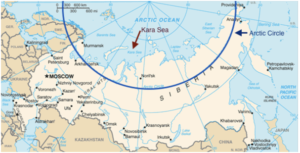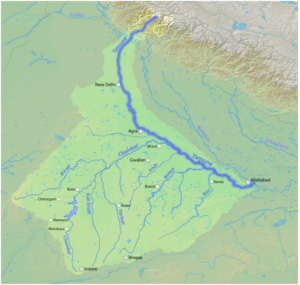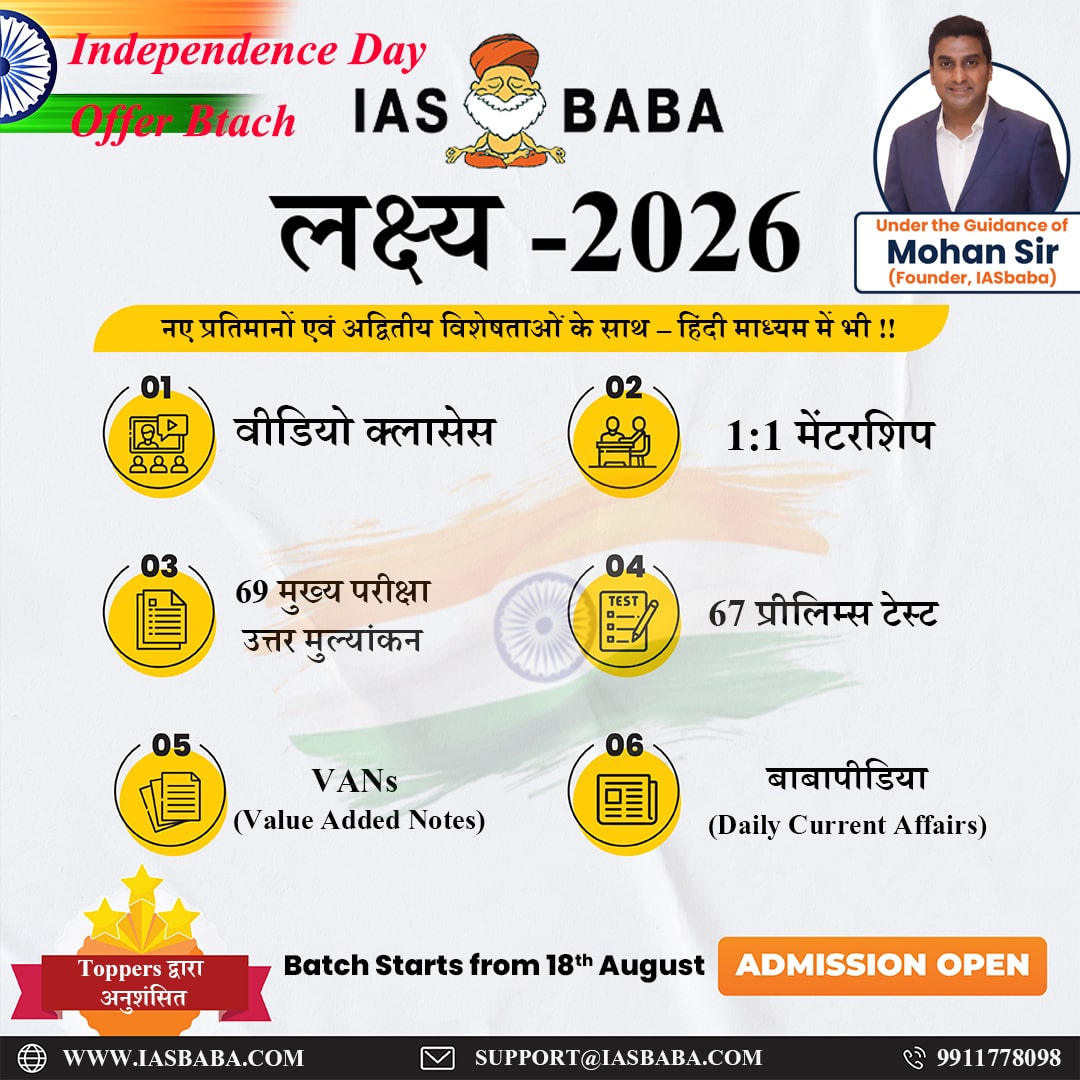IASbaba's Daily Current Affairs Analysis
Archives
(PRELIMS & MAINS Focus)
Syllabus:
- Prelims & Mains – SCIENCE & TECHNOLOGY
Context: Studies of rock and dust from asteroid Bennu delivered to Earth by NASA’s OSIRIS-REx spacecraft have revealed molecules that, on our planet, are key to life, as well as a history of saltwater that could have served as the “broth” for these compounds to interact and combine.
Background: –
- The findings do not show evidence for life itself, but they do suggest the conditions necessary for the emergence of life were widespread across the early solar system, increasing the odds life could have formed on other planets and moons.
- Asteroids like Bennu are remnants from the formation of the solar system, offering a snapshot of conditions that existed more than 4.5 billion years ago.
Key takeaways
- Scientists have revealed that rocks from Bennu contain key components of life: Amino acids, nucleobases and traces of ancient saltwater — the essential ingredients for biological processes.
- Among the most striking discoveries in the Bennu samples are 14 of the 20 amino acids that life on Earth uses to build proteins, as well as all five nucleobases needed for genetic material like DNA and RNA. However, its amino acids show something unusual. Life on Earth mostly uses ‘left-handed’ amino acids, but Bennu has nearly equal amounts of both left- and right-handed types.
- The presence of ammonia and formaldehyde — compounds that can react to form more complex molecules — further strengthens the case for asteroids as potential incubators for prebiotic chemistry.
- Beyond the molecular building blocks, Bennu’s samples also contain traces of water in the form of mineral salts. Scientists detected 11 different evaporite minerals. These minerals suggest that Bennu once harboured briny water that evaporated over thousands, if not millions, of years.
- Similar salty water reservoirs have been detected elsewhere in the solar system, such as beneath the icy crust of Saturn’s moon Enceladus and on the dwarf planet Ceres. The presence of these minerals on Bennu further supports the idea that watery environments, which could facilitate chemical reactions leading to life, were once widespread.
Origins, Spectral Interpretation, Resource Identification, and Security–Regolith Explorer (OSIRIS-REx)
- The Origins, Spectral Interpretation, Resource Identification, and Security–Regolith Explorer (OSIRIS-REx) is a NASA mission designed to study and return samples from the near-Earth asteroid 101955 Bennu.
Key Milestones:
- Arrival at Bennu: OSIRIS-REx reached Bennu on December 3, 2018, initiating detailed mapping and analysis of the asteroid’s surface.
- Sample Collection: On October 20, 2020, the spacecraft successfully collected surface material from Bennu using the Touch-And-Go Sample Acquisition Mechanism (TAGSAM).
- Return to Earth: The sample capsule re-entered Earth’s atmosphere and landed in Utah on September 24, 2023, marking the United States’ first successful asteroid sample return mission.
- Following the successful delivery of Bennu’s samples, the spacecraft was renamed OSIRIS-APEX (Apophis Explorer). It is now tasked with a new mission to study the asteroid 99942 Apophis during its close approach to Earth in 2029.
Source: Down To Earth
Syllabus:
- Prelims & Mains – CURRENT EVENT
Context: In the wake of popular demand for cultivation of cannabis in the Himalayan state, Chief Minister Sukhvinder Singh Sukhu-led Himachal Pradesh government approved a pilot project for cannabis or hemp cultivation.
Background: –
- Cannabis is a naturally occurring weed found throughout Himachal Pradesh, yet its cultivation had been banned under the Narcotic Drugs and Psychotropic Substances (NDPS) Act, 1985.
- With this decision, Himachal Pradesh becomes one of the states, along with Uttarakhand, Uttar Pradesh, Madhya Pradesh, Jammu & Kashmir, and Manipur, to grant controlled permission for the cultivation of cannabis for medical and industrial purposes.
Key takeaways
What does the law say about cannabis cultivation?
- Cannabis cultivation is largely prohibited in India due to its psychoactive properties.
- Section 2 of the Narcotic Drugs and Psychotropic Substances (NDPS) Act, 1985, prohibits the production and sale of cannabis resin and flowers. It defines charas as the separated resin, in any form (crude or purified), obtained from the cannabis plant. It also includes concentrated preparations such as hashish oil or liquid hashish.
- However, it provides exceptions for cannabis cultivation and use for industrial and medicinal purposes under government regulation.
- Section 10 of the Act allows state governments to regulate, permit, or prohibit cannabis cultivation for medicinal and scientific purposes. Additionally, Section 14 grants the Central government the power to authorise and regulate cannabis cultivation for research or other approved purposes.
What is controlled cannabis cultivation?
- It is the regulated cultivation of specific cannabis varieties having minimal intoxicating properties, along with strict monitoring to prevent misuse. Such varieties are commonly known as hemp. The tetrahydrocannabinol (THC) cannabinoid content (a kind of chemical that has an intoxicating effect) in controlled cannabis should be less than or equal to 0.3 per cent.
- Under controlled cannabis cultivation, authorities focus on its non-narcotic applications, particularly in the pharmaceutical and industrial sectors.
- Hemp’s stalks, leaves, and seeds can also be converted into textile, paper, food, cosmetics, biofuel and more. Additionally, cannabidiol (CBD) compounds in the plant are effective in treating chronic pain.
- Before the tightening of restrictions in 2000, cannabis farming was a common practice in Himachal. Despite the ban, illegal cultivation continues in several districts.
- Countries like Canada, the United States, Japan, France, Italy, Hungary, China, Denmark, and Australia are leaders in cannabis farming and its processing.
Source: Indian Express
Syllabus:
- Prelims – GEOGRAPHY
Context: Amid a rapid expansion of Russian activity in the Arctic region, a nuclear-powered icebreaker suffered damage after colliding with a cargo vessel in the Kara Sea.
Background:
- During the winter, nuclear icebreakers frequently accompany oil tankers and LNG carriers across the waters of the Arctic.
Key takeaways
- The Kara Sea is a marginal sea of the Arctic Ocean, located to the north of Siberia, Russia.
- Location: The Kara Sea is bordered by the Novaya Zemlya archipelago to the west, the Severnaya Zemlya archipelago to the east, and the Franz Josef Land to the northwest.
- Climate
- Ice Cover: The Kara Sea is one of the coldest seas in the world, remaining ice-bound for most of the year, typically from September to May.
- Temperature: Air temperatures below 0°C prevail for 9-10 months in the north and 7-8 months in the south. In January, temperatures range from -28°C to -20°C, and in July, they range from -1°C to 6°C.
- Rivers: Major rivers that drain into the Kara Sea include the Yenisey, Ob, Pyasina, and Kara rivers.
- Islands: The Kara Sea contains numerous islands, including the Nordenskiold Archipelago, which is composed of more than 90 islands.

Current Developments
- The incident draws attention to the Northern Sea Route (NSR). The development of this route has emerged as a strategic priority for Russian President Putin.
- Russia has been promoting the Northern Sea Route (NSR) as an alternative global shipping route. Compared to the Suez Canal, the NSR provides faster transit between Northern Europe and East Asia.
- For example, the expected commerce through the NSR will reduce the distance between Shanghai and Rotterdam (the Netherlands’ main commercial port) by over 2,800 nautical miles, or 22%, compared to the Suez Canal route. This route will also likely reduce transportation costs by 30 to 40 percent.
Source: Eurasian Times
Syllabus:
- Prelims – CURRENT EVENT
Context: The World Health Organization (WHO) has announced that Guinea has successfully eliminated the gambiense form of human African trypanosomiasis (HAT), also known as sleeping sickness, as a public health problem.
Background: –
- The only form of human African trypanosomiasis found in Guinea has become the first neglected tropical disease to be eliminated in the country.
Key takeaways
- Sleeping sickness, or African Trypanosomiasis, is a vector-borne parasitic disease caused by the protozoan Trypanosoma brucei.
- It is transmitted by the tsetse fly (Glossina species), which is found only in sub-Saharan Africa.
- There are two types of Trypanosoma brucei that cause the disease:
- Trypanosoma brucei gambiense (T.b. gambiense)
- Found in West and Central Africa.
- Causes chronic infection that progresses slowly over months or years.
- Accounts for over 95% of cases.
- Trypanosoma brucei rhodesiense (T.b. rhodesiense)
- Found in East and Southern Africa.
- Causes acute infection, progressing rapidly over weeks.
- Trypanosoma brucei gambiense (T.b. gambiense)
- Transmission : The tsetse fly bites an infected person or animal and then transmits the parasite to another host.
- The disease can also spread through:
- Blood transfusion
- Organ transplantation
- Congenital transmission (from mother to child)
- Symptoms and Stages – Sleeping sickness has two stages:
- Early Stage (Haemolymphatic Phase)
- Fever, headache, joint pain, and itching.
- Swollen lymph nodes, especially at the back of the neck (Winterbottom’s sign).
- Late Stage (Neurological Phase) : The parasite invades the central nervous system (CNS).
- Early Stage (Haemolymphatic Phase)
- Symptoms include:
- Sleep disturbances (sleeping during the day, insomnia at night).
- Confusion, mood changes, personality alterations.
- Loss of coordination and paralysis.
- If untreated, it leads to coma and death.
- Guinea’s accomplishment is part of a broader trend, with seven other countries — Togo, Benin, Côte d’Ivoire, Uganda, Equatorial Guinea, Ghana, and Chad — also validated by WHO for eliminating the gambiense form of HAT. Additionally, the rhodesiense form of HAT has been eliminated in Rwanda.
Source: Down To Earth
Syllabus:
- Prelims – GEOGRAPHY
Context: Arvind Kejriwal replied to the Election Commission of India’s notice over his claim that the Haryana government was “mixing poison” in Yamuna river, and said raw water received from the state recently has been “highly contaminated and extremely poisonous” for human health.
Background: –
- The Yamuna River is vital to Delhi, providing water to about 70 percent of its population, not to mention its spiritual significance.

Key takeaways
- The Yamuna River is the largest tributary of the Ganga River and one of the most significant rivers in India.
- It originates from the Yamunotri Glacier at an altitude of 6,387 meters in the Uttarkashi district of Uttarakhand.
- States Covered: Uttarakhand, Himachal Pradesh, Haryana, Delhi, Uttar Pradesh, Rajasthan, and Madhya Pradesh.
- Length: 1,376 km, making it the second-longest river in India after the Ganga.
- Major Cities Along Its Banks: Delhi, Mathura, Agra, Etawah, Allahabad (Prayagraj).
- Confluence: The Yamuna meets the Ganga at the Triveni Sangam in Prayagraj, Uttar Pradesh, where the Saraswati River is also believed to join.
- Tributaries: Major tributaries include the Tons, Chambal, Sindh, Betwa, and Ken rivers.
Source: Hindustan Times
Practice MCQs
Q1.) With reference to cannabis cultivation in India, consider the following statements:
- The Narcotic Drugs and Psychotropic Substances (NDPS) Act, 1985 completely prohibits the cultivation of cannabis for any purpose.
- The act allows state governments to regulate cannabis cultivation for industrial and medicinal use under certain conditions.
- Himachal Pradesh is the first Indian state to allow controlled cannabis farming.
Which of the statements given above is/are correct?
(a) 1 and 3 only
(b) 2 only
(c) 2 and 3 only
(d) 1, 2, and 3
Q2.) Why is the Kara Sea strategically important for global trade and geopolitics?
(a) It provides an alternative shipping route to the Suez Canal, reducing transit time between Europe and Asia.
(b) It is the primary route for oil exports from Saudi Arabia to Russia.
(c) It is the warmest Arctic Sea, making year-round shipping possible without icebreakers.
(d) It has the world’s largest deposits of lithium, essential for battery production.
Q3.) The Yamuna River, an important tributary of the Ganga, passes through multiple Indian states. Which of the following statements is/are correct?
- The Yamuna originates from the Gangotri Glacier in Uttarakhand.
- It meets the Ganga River at Triveni Sangam in Prayagraj, Uttar Pradesh.
- Major cities along the Yamuna include Delhi, Agra, and Mathura.
Select the correct answer using the codes given below:
(a) 1 only
(b) 2 and 3 only
(c) 1, 2, and 3
(d) 3 only
Comment the answers to the above questions in the comment section below!!
ANSWERS FOR ’ Today’s – Daily Practice MCQs’ will be updated along with tomorrow’s Daily Current Affairs
ANSWERS FOR 29th January – Daily Practice MCQs
Q.1) – b
Q.2) – b
Q.3) – a













